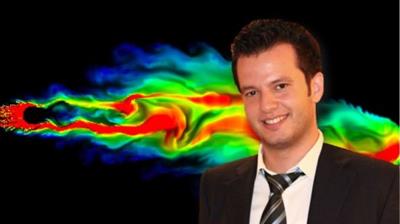
MP4 | Video: h264, 1280x720 | Audio: AAC, 44.1 KHz, 2 Ch
Genre: eLearning | Language: English + srt | Duration: 36 lectures (5h 31m) | Size: 1.39 GB
Forced and Natural Convection Heat Transfer, External and Internal Flow, Nusselt Number Correlations, LMTD Method
What you'll learn:Understand the physical mechanism of convection, and its classification
Visualize the development of velocity and thermal boundary layers during flow over surfaces
Gain a working knowledge of the dimensionless Reynolds, Prandtl, and Nusselt numbers
Distinguish between laminar and turbulent flows, and gain an understanding of the mechanisms of momentum and heat transfer in turbulent flow
Evaluate the heat transfer associated with flow over a flat plate for both laminar and turbulent flow
Calculate the the average heat transfer coefficient for flows over cylinders and spheres during cross flow
Have a visual understanding of different flow regions in internal flow, such as the entry and the fully developed flow regions, and calculate hydrodynamic and thermal entry lengths
Analyze heating and cooling of a fluid flowing in a tube under constant surface temperature and constant surface heat flux conditions, and work with the logarithmic mean temperature difference
Determine the friction factor and Nusselt number in fully developed turbulent flow using empirical relations, and calculate the pressure drop and heat transfer rate
Understand the physical mechanism of natural convection
Evaluate the Nusselt number for natural convection associated with vertical, horizontal, and inclined plates as well as cylinders and spheres
RequirementsFundamentals of Heat Transfer Part 1
Fundamentals of Engineering Thermodynamics
Fundamentals of Fluid Mechanics
DescriptionWelcome to Fundamentals of Heat Transfer Part 2.
So far we have focused on heat transfer by conduction and have considered convection only as a possible boundary condition for conduction problems in part 1. we used the term convection to describe heat transfer between a surface and an adjacent fluid when they are at different temperatures. We learned also that knowledge of the convection coefficient is required to use Newton's law of cooling to determine the convective heat flux. In addition to depending upon fluid properties, the convection coefficient depends upon the surface geometry and the flow conditions.
In this part, our first objective is to develop an understanding of boundary layer phenomena and the features that control the convection coefficient. Our second objective is to learn how to estimate convection coefficients in order to perform analyses on thermal systems experiencing different types of flow and heat transfer situations. We begin by addressing the problem of convection. We will discuss the hydrodynamic boundary layer concept and the thermal boundary layer which is the region of the fluid next to the surface in which energy exchange is occurring, and discuss its influence on the convection coefficient.
In this course, we will consider forced convection and introduce methods for estimating convection coefficients associated with external and internal flows. Moreover, we will consider free or natural convection and present methods for estimating the convection coefficients for common geometries.
I wish you good luck in learning heat transfer.
Enjoy and happy learning!!
Who this course is forEngineering Students
Download link:
Só visivel para registados e com resposta ao tópico.Only visible to registered and with a reply to the topic.Links are Interchangeable - No Password - Single Extraction

